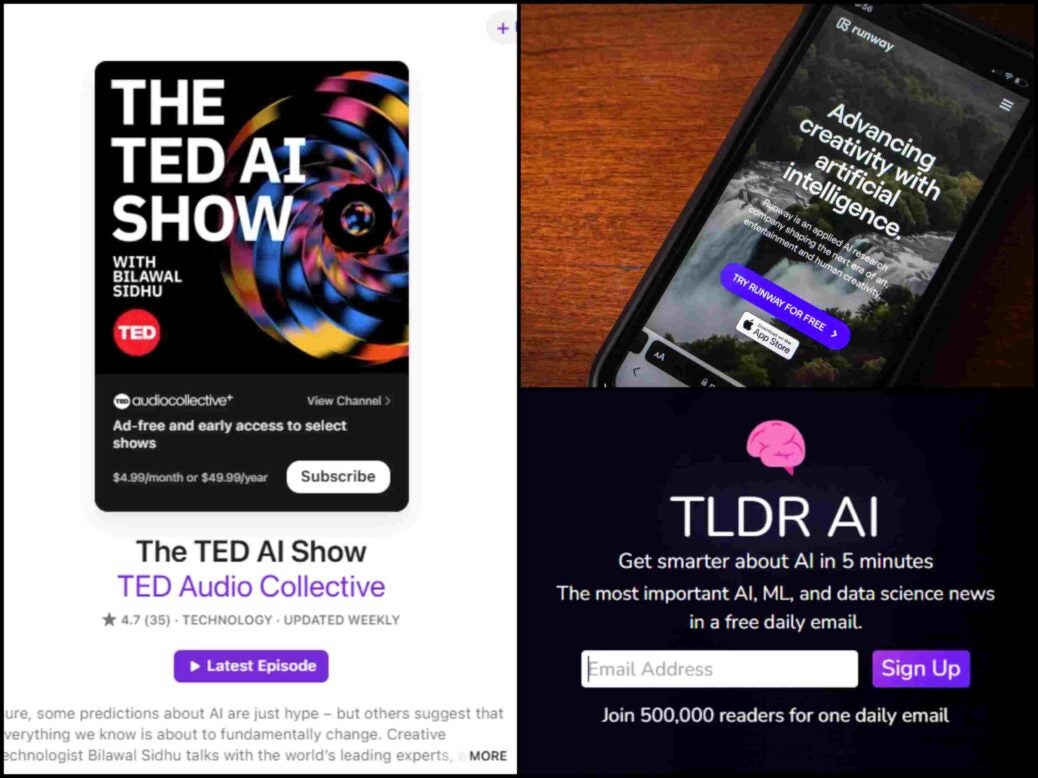
Since setting out on the Oxford University Artificial Intelligence programme at the beginning of the year, the question I’ve been asked most often from journalists, publishers and senior execs is “What’s the best way to keep abreast of AI developments?”
So if you are looking to stay ahead of the AI curve, this article is for you.
Let’s look at five easy ways you can keep your finger on the pulse of AI developments and get a solid grasp on how to apply them in the publishing world.
No tech knowledge required, just a bit of time and attention.
1. Tune into AI-focused podcasts
Who says you can’t multitask your way to AI expertise? Here are some top-notch podcasts to plug into during your commute or morning jog:
Produced by Andreessen Horowitz, this Silicon Valley VC-backed show delivers deep dives into tech trends. It is consistently ranked among top tech podcasts and is one of my personal favourites.
Hosted by ex-Google product manager Bilawal Sidhu, this weekly podcast dissects AI’s societal impacts – from deepfakes eroding reality to AI’s role in mental health – while maintaining an accessible tone for non-technical listeners. It’s a great listen for beginning to understand AI’s cultural ripple effects
Hosted by Daniel Faggella, this weekly show is a goldmine for execs looking to integrate AI into their business practices. With episodes averaging a digestible 27 minutes, you’ll get insights from some of the big players including IBM and Mastercard on AI use cases, best practices, and keys to success.
Elad Gil and Sarah Guo bring you conversations with the crème de la crème of AI engineers, researchers and entrepreneurs. It’s like eavesdropping on the smartest people in the room discussing AI breakthroughs and their impact on industries like ours.
Recommendation: Block out 30 minutes in your calendar each week for a podcast session. It’s a great investment of time; your future self will thank you.
2. Get AI news delivered to your inbox
Let’s face it, your inbox is probably overflowing already. But these two newsletters are worth making room for:
- TLDR AI: Daily AI news summaries that won’t put you to sleep.
- The Rundown AI: A weekly dose of AI trends and applications.
Recommendation: Create an “AI Intel” folder in your email. Skim these newsletters with your morning coffee, you’ll feel smarter by lunchtime.
3. Level up with AI education
Time to go back to school (sort of).
The Oxford University/Said Business School AI Program is the course I’m studying currently. It’s only six to eight weeks depending on how much time you can put aside each week (six weeks requires around 20 hours a week, eight weeks cuts the weekly commitment to around 15 hours per week).
It’s like getting a mini AI MBA, minus the two years and mountain of student debt. The course is well structured with a mixture of online learning, live sessions and plenty of opportunities to connect and discuss with fellow students. Harvard Business School and MIT Sloan School of Management both offer similar programmes.
If you can’t commit that amount of time, try Coursera’s AI for Everyone or take a look at some of the excellent free AI and machine learning tutorials available on Google.
Recommendation: Pick a course and commit to finishing it this quarter. Better yet, make it a team challenge and get some of your peers involved.
4. Rub elbows at AI Events
Nothing beats face-to-face learning and networking: a few suggestions for your diary…
- Press Gazette’s Future of Media Trends takes place in London on 24 April
- The World Association of Newspapers will host the Frankfurt AI Forum on 31 March to 1 April
- FT Live: The Future of AI – Unlocking the next phase of innovation – takes place on 5-6 November.
Recommendation: Earmark funds for at least one major AI event this year. Consider it an investment in your company’s future.
5. Get Your Hands Dirty with AI tools
Time to roll up your sleeves and play with some AI toys:
- Generate dynamic video content from static images and text, perfect for creating engaging social media teasers from print articles.
- Implement C2PA [Coalition for Content Provenance and Authenticity]-compliant watermarking for AI-generated content, maintaining transparency and trust with your audience.
- Create AI avatar-narrated videos to repurpose long-form content into digestible, shareable formats.
- Scale multilingual content production without additional resources, expanding your reach to diverse audiences.
- Streamline research with AI-powered source management, importing and organizing various document types and languages.
Recommendation: Set up an AI playground in your office. Let your team loose on these and other AI tools and see what creative ideas emerge.
Navigating the AI minefield
Now, let’s talk about the elephant in the room: AI isn’t all rainbows and unicorns. There are some pitfalls to watch out for:
- Privacy concerns: Make sure your AI isn’t creeping on your readers
- Algorithmic bias: Because we want AI that’s fair, not AI that’s judgy
- Transparency issues: Keep it clear how you’re using AI, or risk losing the reader trust that has taken decades to build
- Ethical considerations: Develop an AI code of conduct. It’s not just good karma; it’s good business.
Remember, with great AI power comes great responsibility. Stay curious, but stay cautious.
By following these strategies, you’ll be well on your way to becoming the AI-savvy publishing exec everyone wants to be.
Just remember to balance your enthusiasm with a healthy dose of scepticism, and you’ll be navigating the AI landscape like a pro in no time.
Read Paul Hood’s other columns providing AI insights for publishers here.
Email pged@pressgazette.co.uk to point out mistakes, provide story tips or send in a letter for publication on our "Letters Page" blog
